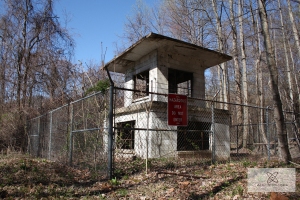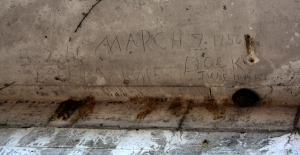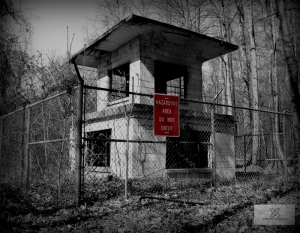Hidden in the mountains of east Tennessee, just outside the hamlet of Petros lies the now closed Brushy Mountain State Penitentiary, once a key part of the Tennessee penal system. It doesn’t have the fame of Alcatraz or other well known prisons but it was just as important and mysterious. It was constructed by inmates from stone quarried on site and looks like a castle, it must have been something to build their own prison. From above one can see it is shaped like a cross which illustrates the importance of religion to the people of the area. It’s history is long and complicated, it is one of the oldest penitentiaries in the US, and I won’t go into it all here we are mainly focusing on its associated mines which I have now explored three times. The mines are, in fact, the reason Brushy Mountain (or just Brushy as locals call it) exists in the first place. The history of the mines is a story of free miners and convict miners and a mostly unknown uprising known as the Coal Creek War.
The Coal Creek War
This too is a long and complicated story but I’ll just supply the basics. Once upon a time in TN there was a system instituted known as the “convict-lease” system where prisoners were worked by the state to “repay their debt to society.” This was common in the south after the civil war. It all began because of a debt that the state incurred after the civil war at where they had helped supply the Confederate army of the state. In an attempt to make the prison system break even the legislature came up with the convict lease system in 1865 where prisoners would be leased to companies to make money for the state to try and repay the debt. Fast forward to 1871 and prisoners were being leased to railroads and mining companies. Many escapes occurred on railroad gangs but few in coal mines for obvious reasons. Already, free industrial workers were complaining about the competition from convict labor. Now fast forward to 1889, the Tennessee Coal, Iron, and Railroad Company came to the state and asked to lease a large number of convicts to work in mines near Briceville, Lake City (then known as Coal Creek), and other places. The first insurrection by free miners took place in 1891 in Briceville but it was only the beginning.
Throughout 91′ and 92′ free miners burned coal company buildings and released hundred of prisoners from stockades sometimes loading them a hundred or more at a time on trains and sending them off. This occured several times around Briceville; Tennessee state militia had to intervene several times and enforce the convict labor system. In just one example at Oliver Springs miners stormed a stockade and when the guards refused to release the prisoners the miners exchanged gunfire with the guards for a half hour, left, then returned with reinforcements and put the inmates on a train bound for Knoxville and burned the stockade. This happened until the end of the lease system in the mid 1890’s. In 1893 the state legislature approved a bill allowing for the construction of a new prison to house and work the convicts which would later become Brushy Mountain.
Brushy and her Mines
The state ended up purchasing 13,000 acres for the prison site and Morgan county was expanded into Anderson county so it would all be in one county. Today the Frozen Head State Park is comprised of some of these lands and it borders the prison site, the mines are considered part of Frozen Head. A 20 mile railroad line from Harriman was constructed (largely by prisoners of course) so coal could be hauled from the mines. The state installed ovens to increase the value of the coal by “coking” it (burning it at a high temperature, as much as 2,000°C) to produce a material used in steel production known as “coke.” Men that has worked in the coal mines already continued to do so at the new prison, while other convicts worked the ovens, coal washer, tipple, etc. By 1896 the miners were pulling 1,000 tons a day out of the mountain.
However, working hundreds of prisoners in cramped and dark tunnels was risky and on several occasions there had been escape attempts, hostage taking, and sabotage. In 1959 a large rebellion inside the mountain of 95 men made national headlines, the prisoners eventually got starved into surrendering but after it ended booby traps were found inside including ones rigged to sticks of dynamite. One newspaper excerpt I found said the miners had 200 sticks of dynamite and threatened to destroy the shafts if their demands for better working conditions were not met. This was likely one of the final nails on the mines’ coffin. I haven’t been able to find much information about previous incidents other than references to the fact that they occurred. The mines opened just after the Coal Creek war in 1896 and operated until 1966 from what I can tell, 70 continuous years. There are several mines collectively known as the “State Mines” and I believe there were multiple ones operating simultaneously. They appear to be on four levels of the mountain, presumably where the different seams were. I am also fairly sure that some entrances have disappeared with time. Photos of the original operations seem to be hard to come by and I am still fuzzy as to how all the pieces of the puzzle fit together.
Lets Explore!
The site itself is part of Frozen Head State Park and can be accessed from a gated road on hwy 116 at Armes Gap. The trail here is the Lookout Tower trail formerly a 4×4 road now closed to vehicles. If you stay on this trail you will end up at the top of the mountain and the lookout tower, but we cut off before that. The trail to the first set of mines cuts off to the left a mile or so up the trail in the middle of a big incline, the mine trail stays level. On the Frozen Head trail map this is the “Old Prison Mine Trail.” Walk for a couple of minutes on the flat former tram road and you pass a large open area with little trees and then quickly you stumble upon the first mine opening.

This is the first mine opening (or Portal, or Drift Mouth) on the trail, it appears to be very old and is gated.
The first opening is old and gated with old iron bars very much like…prison bars. Until recently I hadn’t considered the possibility that this entrance was sealed in this manner to keep in prisoners and not for keeping the public out, although I could be wrong. The ceiling inside has collapsed and the timbers look very old and weathered. This entrance could have been used for ventilation and barred to keep prisoners from running out this portal. What looks like a road in front is actually the tram road running over a bridge-type structure built in front of the portal, the opening is larger than it appears in this image extending below the road behind the gated portion.

Intatct gaurd tower surrounded by a fence, though my friend pointed out the gate was open last time I was there.
Just a few more steps down the road is the real evidence of convict labor being used, an intact guard tower. The two pics I have seen of these mines have wooden guard towers so this must have come along in the final days of the operation. In my opinion this may have been the last mine to have been worked. Directly in front of the tower is a well preserved cement portal that still has mine track ties inside with spikes in them.
In addition to the ties a large braided steel cable also lays on the ground in the entrance. On inside a few feet the tunnel has collapsed (or been intentionally collapsed) barring any further exploration. Speaking of, it should be said that exploring any mine is extremely dangerous and reckless if you want to continue living, but coal mines are much more dangerous than other types as they are often damp, unstable, and gassy.
On past the guard tower are two small closet sized building presumably used to store explosives, one has dirt pushed up in front likely to direct the explosion if one occurred. There is also a smaller oddly shaped building with a small opwning that may have been a fan house. It’s roof is partially collapsed and I had to crawl on my knees to peek inside. There is also a small foundation area where a wood building likely stood. There were probably lots of wooden buildings that no longer exist for that matter.

Weird small structure built into the hillside a few feet from the cement portal. The opening is about four feet high and the roof slopes down over the opening. A recent comment from a reader indicates that this is likely a fan house.
Off in the woods below the barred portal are other foundations and bits of cement that can be found hinting at a myriad of buildings that once populated the hillside. Also, there are some ruins of the cable incline that lowered cars up and down the mountain. Up above the rock wall to the right of the cement portal is a large flat concrete pad with two pipes sticking out of each corner with an unknown purpose. There is also a large capped metal pipe sticking up out of the ground. Someday, I hope to find more information about how these mines functioned. I would love to locate some historical photos to compare to my own present day photos. This is an interesting piece of industrial history as there are special circumstances in play, they were functioning mines but with the guard towers and maximum security inmates doing the work. This concludes whats along this bench. When I get time I will put up Part II up above this area and the “mega mine” that I found there. I’ll leave you with some old writing my friend Troy spotted on the underside of the roof of the guard tower.

Writing on the underside of the guard tower roof and on the walls. It’s hard to read but it looks like the tower was used for a chalkboard! There are tons of dates around the 50’s, the date 3-2-1956 is the largest and most obvious it’s also wrote out as “March 2, 1956.” “Dock” is signed under each date. “Armes” appears frequently as well. There is also other dates nearby: 2-19-55, June 11, 1956, June, 10, 1953, and tons of others I can’t read. For what purpose they were written I don’t know, or who Dock was.
***Update***








